Featured image: Pennsylvania Association Football Union season preview detail, Philadelphia Inquirer, October 19, 1891
Maintaining Philadelphia’s first organized soccer league, the Pennsylvania Football Union, after its inaugural 1889-1890 season initially looked to be something of a shaky proposition. Before the second season, inaugural champions Eddystone, as well as Philadelphia South End, Kensington Rovers, and the Shamrocks, all dropped out of the league, now referred to as the Pennsylvania Association Football Union (PAFU), leaving only Philadelphia North End from the founding roster of teams. Their places were taken by Frankford, Tacony, Nicetown, Manayunk, and Oxford, thus bringing the total number of participating clubs to six, and the new season commenced on October 11, 1890.
Several of the clubs that dropped out of the PAFU continued to make non-league appearances; presumably they lacked the funds to join the league or pay for travel expenses, or perhaps they simply did not have the players to continue. Nevertheless, the Philadelphia Inquirer reported on October 13, 1890 that “Association football is growing in favor” and that “the prospects for the Association were never brighter.” On January 5, 1891, the Inquirer reported, “The Association game is gaining great popularity in this country and bids fair to rival some of the better known sports.” This rising popularity was generally ascribed to “the absence of brutality and roughness from the game, and the science necessary to play well.” Locally, this was “greatly due to the way in which THE INQUIRER has advocated the game.”
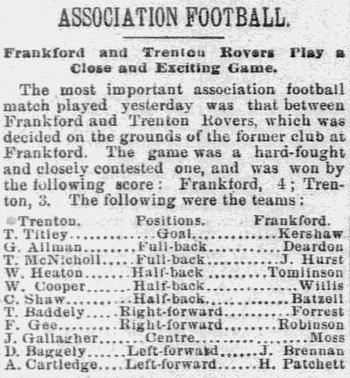 Games were played at the Germantown Base Ball Grounds, Frankford Junction, Stenton, and Wayne Junction. Non-league matches against new clubs such as Enterprise, Celtic, Athletic, Thistle, Peerless, and Orianna also took place, as did a series of interstate games against Trenton Rovers and Trenton Association, the first of which was played on November 29, 1890 against Trenton Rovers and was won by Frankford, 4-3. The Rovers would soon get their revenge against Pennsylvania teams when they defeated Tacony 3-0, on December 13. Playing at home on January 10, 1891, Trenton defeated a shorthanded Tacony, 4-1 — “The visitors came with two men short.”
Games were played at the Germantown Base Ball Grounds, Frankford Junction, Stenton, and Wayne Junction. Non-league matches against new clubs such as Enterprise, Celtic, Athletic, Thistle, Peerless, and Orianna also took place, as did a series of interstate games against Trenton Rovers and Trenton Association, the first of which was played on November 29, 1890 against Trenton Rovers and was won by Frankford, 4-3. The Rovers would soon get their revenge against Pennsylvania teams when they defeated Tacony 3-0, on December 13. Playing at home on January 10, 1891, Trenton defeated a shorthanded Tacony, 4-1 — “The visitors came with two men short.”
Trenton before Philadelphia
Trenton had gotten a head start over Philadelphia in organized play. Melvin I. Smith records in Evolvements of Early American Foot Ball (2008) that high school soccer was being played in Trenton as early as 1878 with Trenton High School (now Trenton Central High School) defeating Trenton Independents 2-0 on December 1, and then defeating the Trenton International team 8-0 on December 27. On November 29, 1883, the Trenton Delaware Fire Company played a “Marrieds vs. Singles” game. The result is not recorded but the “Marrieds vs. Singles” format evoked something of soccer’s folk football roots. In 1885, the Trenton Eagle Potters — an apt name given Trenton’s prominent place in the country’s pottery industry — lost to Kearney’s Clarks ONT team on April 11 before defeating the Trenton Knights of Labor at Hetzels Grove in front of 1,200 spectators. On July 11, the Eagle Potters played a picked Trenton team at the East State Street grounds in Trenton, but no score is recorded.
The Trenton Association team played at least ten games in the 1885-86 season, accruing a 4-5-1 record against opposition that included American Football Association sides Clarks ONT, Newark Almas, and New York Riversides. Indeed, Trenton Association’s 4-0 loss to Kearney Rangers on October 24, 1885 in the first round of the second edition of the AFA’s American Cup tournament would mark the first appearance in the tournament by a team from outside the Newark-Paterson-New York area. In the 1886-87 tournament, the Trenton Football Club defeated Paterson 3-2 on November 25, 1886 at the Trenton Cricket Grounds, after first drawing 1-1 on the road in Paterson on October 30. Trenton FBC then defeated New York FBC 3-1 in the second round on Christmas Day at the East State Street grounds before falling 5-0 to eventual champion ONT in the semifinals on February 19, 1887.
A Trenton team entered the 1887-88 American Cup, the first to include teams from the New England region, but it is unclear if they actually played. Nevertheless, Smith has located records showing that season saw games from Trenton Swifts, Trenton Tile Rovers, Trenton Butler Streets, and Trenton Young Americans. The next year, Trenton Association fell 3-1 to New York Thistles on October 20, 1888 in the first round of the tournament, while Trenton Rovers drew 0-0 with ONT on the same day before forfeiting the return game. Trenton Swifts won the 1888-89 New Jersey Junior Football Association championship, a four team league that included the Kearney Clarks ONT Seconds, Kearney Rovers, and Newark Alma Maters.
As we have seen, on January 19, 1889, Philadelphia North End traveled to face Trenton Rovers at Hetzels Grove, where they were crushed 9-0 by their more experienced New Jersey opposition. At Chester Park on February 23, the Eddystones exacted some Pennsylvania revenge with a 3-2 win over the New Jersey side. The two teams met again on July 4 in Trenton, but the result is not available.
In the 1889-90 American Cup, Trenton Potters made it as far as the semifinals, where they lost 5-1 to Kearney Rovers on January 18, 1890.
New concerns and a new trophy
With the PAFU seemingly back on track, attention could begin to turn from making sure there were enough teams to sustain the league to improving the quality of play. A Philadelphia Inquirer report from December 13, 1890 on a match between Nicetown and Manayunk noted the sorry state of the playing surface, the need for Manayunk to get several last minute substitutes in order to field a full team, as well as the problem of finishing the game before it was too dark to see the ball. Occasionally, a team would fail to turn up for a match, as was the case when Frankford traveled to Tacony for a game on January 3, 1891 and found no team to play. Inquirer reports in December, 1890 celebrated the fact that for the first time, all of the teams that started the season remained in the league at the halfway point of the season and described growing crowds: “where the spectators formerly amounted to thirty or forty they may now be counted in by the hundreds” with “nearly 500 spectators” watching a match between North End and Tacony at Stenton on December 20, and “nearly 800” attending a match between Trenton and Tacony on Christmas Day, 1890, one of six matches played that day.
On December 29, 1890, the Philadelphia Inquirer trumpeted that the eleven league and non-league clubs currently playing in Philadelphia were “three more” than in New York and Brooklyn. The report also described the finances of the PAFU as being in “flourishing condition,” and enthusiastically supported a proposed “match by electric light.” However, matches continued to be potentially very disorderly affairs: on December 15, in view of “the frequent disputes that occur during the game,” the Inquirer called on league officials to provide more support for referees’ decisions “to stop the game or disqualify players.” On December 29, the Inquirer also noted that the teams poaching of players from their rivals was a problem.
The absence of some kind of trophy for clubs to play for was also viewed as an issue that needed to be addressed and on January 5, 1891, the Inquirer suggested that the PAFU take steps “to secure a cup or banner, so as to make the union appear more businesslike.” In the league’s inaugural season the first and second place team players had been awarded medals. The Inquirer reported on January 19, 1891 that “one or two” delegates “whose clubs have no possible chance of winning the championship, are in favor of buying a cup and letting the winning team go without medals,” which the Inquirer regarded as “manifestly unfair to the players who have thus far striven with might and main to win and who naturally expect to be honored by a medal if they succeed.” While the “one or two” delegate were not named, Manayunk withdrew from the league the next week. “[L]ack of support and interest” were the reasons reported in the February 2 edition of the Inquirer, leaving North End, Frankford and Tacony vying for the league championship.
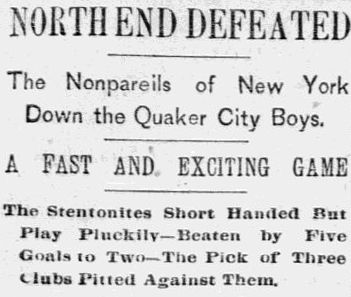 On February 22, North End traveled departed by rail from the Ninth and Green Street station to face the Nonpareils in Brooklyn. For North End, it would have been a rare Sunday game, and it was the first time a Philadelphia team had played in New York. North End had played Trenton Association the day before at home, winning 3-2. The Inquirer said of the conditions for the Trenton game, “A drizzling rain fell throughout the afternoon and made playing dangerous,” which may have something to do with why North End arrived in Brooklyn without several key players. North End lost 5–2, although the Inquirer reported that the Nonpareils fielded a number of players from other clubs (namely, the Caledonians and Thistles) and “three of the five goals kicked [were] credited to outside players of the home team.” Outside left Bobbie Barr scored both North End goals.
On February 22, North End traveled departed by rail from the Ninth and Green Street station to face the Nonpareils in Brooklyn. For North End, it would have been a rare Sunday game, and it was the first time a Philadelphia team had played in New York. North End had played Trenton Association the day before at home, winning 3-2. The Inquirer said of the conditions for the Trenton game, “A drizzling rain fell throughout the afternoon and made playing dangerous,” which may have something to do with why North End arrived in Brooklyn without several key players. North End lost 5–2, although the Inquirer reported that the Nonpareils fielded a number of players from other clubs (namely, the Caledonians and Thistles) and “three of the five goals kicked [were] credited to outside players of the home team.” Outside left Bobbie Barr scored both North End goals.
North End could take consolation when they won the league championship a week later on February 28 by defeating Frankford 3-1 at Frankford Junction before “between seven and eight hundred spectators.” The players would be awarded gold medals and the champion club a trophy, named after its donor, the Philadelphia Public Ledger publisher, trustee of Drexel University, and philanthropist George W. Childs.
Non-league matches continued through April, including games at home and away against Trenton teams on March 7, both of which were lost by the Philadelphia sides, with North End — “minus several of their best players — losing 3-0 in Trenton, and Enterprise losing 6-2 in Philadelphia. On March 21, North End defeated Trenton Rovers 5-0. Frankford traveled to Trenton on March 28 only to return 4-1 losers.
The George W. Childs Cup — “which is of elegant design and workmanship and of solid silver,” the Inquirer reported — was presented on April 11, 1891 at a banquet held at Maennerchor Hall, located at Franklin and Fairmount Avenue in Northern Liberties. Representing George W. Childs at the banquet was Horace Fogel, the noted Philadelphia sportswriter and baseball authority. Fogel became the owner of the Philadelphia Phillies in 1909. He was banned from baseball in 1912 after he accused umpires of being pro-New York.
Three days before the award ceremony the Inquirer published the rules that were to govern future Championship Cup competitions: only member clubs of the PAFU could compete for the cup; the competition was for amateurs only, the definition of “amateur” being subject to interpretation by the Committee on Rules of the PAFU; competing teams were to be made up of eleven players each with each player being a “bona fide” member of the club represented by each team; the winning club would be awarded the cup after the PAFU had received from the club “security for its safe return;” the cup was to be returned immediately to the PAFU after it had been won by a new club and “under no circumstances shall it become the permanent property of any individual club or organization;” in the event of the disbandment of the PAFU, the cup was to be returned “at once” to the representative of the league.
Enjoying the support of the Philadelphia Inquirer, with growing attendance of matches, and the successful completion of its second season, the PAFU had reason to be proud. For champions North End, however, the season ended on a sour note. On April 25, North End traveled to Trenton to face the Rovers. The Inquirer reported, “The game was a brutal one, the Rovers jumping on and kicking the visitors.” When the referee awarded North End a goal, he was attacked by a Trenton player “and a fight ensued with both teams joining in.” The Inquirer reported, “Order was at length restored and the game resumed.” Trenton won the match 3–1.
Growth continues in third season
The 1891–92 season started with seven teams in the PAFU. North End, Frankford, Oxford and Tacony were joined by Enterprise, Athletic and Philadelphia (who had participated in the league’s first season and were also referred to as South End, playing their home matches in the Point Breeze neighborhood of the city). Manayunk failed to rejoin the league and Nicetown deciding to not continue its league participation. Most of the league’s players were foreign born, something that was underscored by the tournament organized by the Sons of St. George on July 21, 1895. The Inquirer reported on July 26 that “from a thousand to fifteen hundred people” were in attendance at Frankford Junction for the one-day tournament which was won by Frankford. Outside of the games themselves, the highlight of the day was a kicking competition, won by Norristown goalkeeper Herbert C. Crowhurst, who despite being injured in a game just before the kicking competition, “sent the leather flying 171 feet 8 inches.” The Inquirer noted, “This beats the American record by just over a foot.” Nevertheless, the Inquirer did note on December 28, 1891 that “the majority of the Oxford players are Americans.”
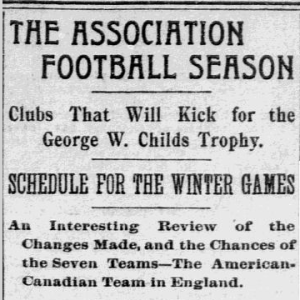 Tacony and Frankford, who were viewed as the strongest teams in the league, met on the opening day of the season on October 10, 1891. Frankford, wearing red and black, were down two goals to the red-clad Tacony team at the half but stormed back to win 3–2.
Tacony and Frankford, who were viewed as the strongest teams in the league, met on the opening day of the season on October 10, 1891. Frankford, wearing red and black, were down two goals to the red-clad Tacony team at the half but stormed back to win 3–2.
The roster for reining league champions North End was almost entirely different from the previous season with only “three or four of the old players” on North End being joined by “three cracks from England and a couple of good players from one of the New York Clubs,” the Inquirer reported on October 19. In their opening game on October 17, the champions suffered a 5–2 loss against newcomers Athletic, who fielded “two of the finest forwards in the country,” including former North End outside left Bobbie Barr. Now playing inside left, Barr scored four goals against his former club in the win. Four former North End players were now wearing the red jersey of Tacony, the Inquirer reported, “three of them being forwards and one full back.” Former North End captain Jack Monaghan was now leading the Oxford team. With such losses the team’s prospects for the new season were dim.
While league play continued, efforts were also underway to organize an all-Philadelphia team to play an all-Trenton team, as well as a hoped-for match against the American-Canadian team that was then touring Britain and was due to return to New York at the end of January.
Participation in soccer was strong enough that most of the clubs could field reserve teams for matches. At a PAFU meeting in November it was proposed that each club organize a junior eleven limited to players aged 18 or younger to play in a championship tournament. Soon, six of the seven senior PAFU clubs were fielding junior teams.
Match attendance also continued to improve. A meeting between the hitherto unbeaten Oxford and Frankford clubs drew some one thousand spectators to witness Oxford’s first loss of the season. Two thousand would gather in “miserable weather and driving rain” to watch a Thanksgiving Day inter-city match between the Cosmopolitans of New York and North End. Perhaps learning from their experience against the Nonpareils in Brooklyn earlier in the year, the North End team was actually an all-Philadelphia team “composed of players selected from the Pennsylvania Football Association.” North End won, 3–0. (For more on the Philadelphia-Cosmopolitans series of the early 1890s, see Philly and the New York Cosmopolitans.)
On December 28, 1891, the Inquirer reported, “Interest in association football has shown a gratifying increase, the most marked feature being the larger attendance, which this season has more than tripled that of 1890.” The strong attendance numbers continued through the rest of the 1891-1892 season with second place Tacony defeated first place Frankford 2–1 in front of over two thousand spectators on January 9, 1892.
Interest in soccer also seemed to be spreading to the high school and university level as Inquirer match reports from the 1891-1892 season mention attendance by representatives from Central High School, Cheltenham Military Academy, Manual Training School, and the University of Pennsylvania. Non-league matches continued between PAFU clubs and other Philadelphia clubs such as Crescentville and Orianna, as did inter-city matches, with PAFU clubs playing sides from Wilkes Barre, Trenton, Paterson, N.J., and Brooklyn.
Inter-city matches were a good marketing tool for the game and for the league, and the All-Philadelphia vs. All-Trenton series evoked great interest. Over two thousand spectators were treated to a 5-0 Philadelphia win at Frankford Junction on January 30, 1892. A return match in Trenton on February 22 in front of one thousand spectators saw Philadelphia lose, 3-1.
The series continues next week.
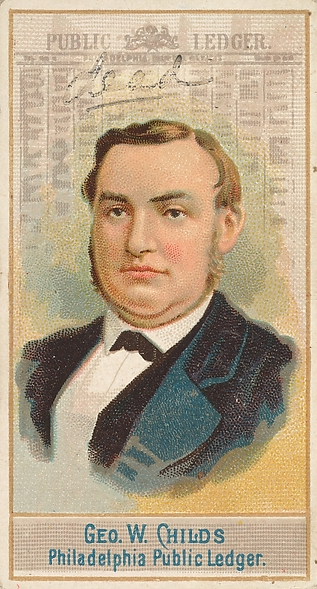
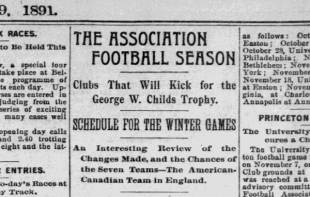

This North End squad seemed really solid